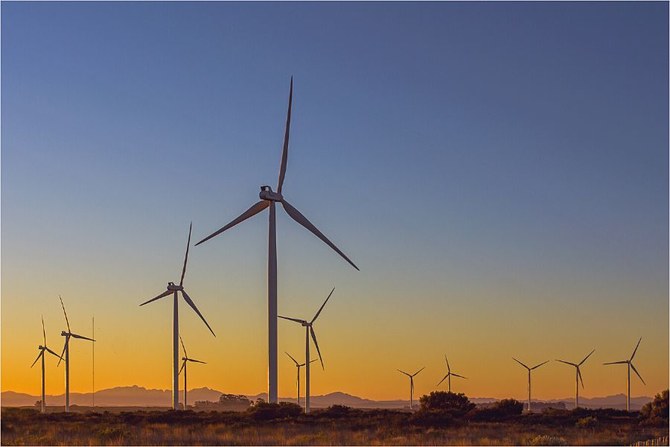DUBAI: NEOM’s water and electricity subsidiary ENOWA has developed a blueprint for the world’s first renewable, high-voltage smart grid, Peter Terium, the company’s CEO, told Arab News.
In an interview on the sidelines of the 2023 UN Climate Change Conference, Terium said that the “grid of microgrids” will allow ENOWA to supply the NEOM region with sizable, 100 percent renewable electricity that simultaneously provides a 50 percent reduction of the corridor footprint.
According to the CEO, the principle of smart grids is simple, as they are traditionally used on a small scale in buildings. However, the sheer size of the development and the scope of coverage needed for the nine to 10 million individuals who will be residing in NEOM adds to the difficulty of the undertaking.
“That’s a huge achievement given it’s the size that makes it complex. You know, one windmill, a refrigerator, and a television are all 100 percent renewable. But a NEOM within the Kingdom that eventually is going to have nine to 10 million inhabitants. That’s very sizable,” Terium said.
In order to ensure minimum disturbance to the natural terrain and minimize visual disruption, the CEO noted that this would require limiting the number of corridors and implementing part of the grid to operate underground.
To achieve 100 percent renewable electricity in NEOM, Terium emphasized the crucial role of an efficient grid, highlighting that individuals often underestimate that all solar and wind farms require connectivity to “bring the electrons to the customer.”
Another key element, the CEO underscored, is storage. In order to ensure the stabilization, backup, and security of its renewable supply, the giga-project is implementing a portfolio of storage solutions.
The development is investing “billions and billions of Saudi riyals” to ensure that its first customers have access to green electricity, sustainable water, and reliable quality electricity through its grid and storage.
“One example is already for sure and we are expanding into the market with that, which is the world’s largest closed-loop pump, hydro storage, and it combines the traditional form of water-based hydro storage, so a small upper lake and a lower lake,” Terium said.
“That has two effects. First of all, it reduces the evaporation of the water. So that’s an economic effect. But the second effect is that it is a great attractor for birds. Birds and wildlife. So we have a major positive solution for storage that is pretty sizable, the largest in the world,” he added.
Considering the challenges ahead, the CEO highlighted that the development isn’t exclusively centered on creating new technologies. Instead, their key focus is to ensure that the electricity supplied to the NEOM region is renewable, dependable, and affordable.
While not entirely cheap, mature large-scale solar and wind technologies remain affordable, underscored Terium, and will thus be primarily implemented into the framework of connectivity used by the futuristic city.
“The NEOM region has a combination of very intensive solar irradiation and very abundant wind profiling — the solar during the day and the wind mainly in the evening. That makes it a perfect combination to take these two cheapest renewable technologies and get as much as possible out of them,” he outlined.
While the existing infrastructure for electricity amounted to half a gigawatt to 1 GW, the company has “ramped that up” to 3 GW with the aim of 5-6 GW in the near future.
According to Terium, the first tenders of solar and wind power plants have already been established, and the large green hydrogen plant being built will amount to 5-6 GW of installed capacity for power generation by the year 2026.
Due to the size of the NEOM development, the executive underscored that ENOWA is currently at about 5 percent completion of its infrastructure, with the goal of accelerating to 10 percent in the coming 12 to 18 months.
He said: “NEOM is going to be a large undertaking. And what we do is build the infrastructure in line with the growth of NEOM. So that’s why the percentage of 5 or 10 percent sounds low, but it is connected to the size, eventually, of NEOM. And then again, five or 10 eventually of a massive undertaking is already a huge project.”
The company is working with the Kingdom’s Ministry of Energy and collaborating with entities like the King Abdullah University of Science and Technology in its energy-centric ventures. Alongside KAUST, ENOWA will be installing the first carbon capture capacity into a gas-fired plant in the Kingdom. The executive said: “That is one example, but there are many other ones and all the institutions that are there in the Kingdom we work with, but also outside of the Kingdom.”
Through collaboration, it hopes to bring some of its ideas on how to scale renewable energy to the region through its renewable energy approaches and Saudi Arabia’s green hydrogen strategy, a part of which is the NEOM green hydrogen plant.
Terium said: “The Kingdom has now embarked upon a hydrogen strategy and a renewable energy strategy, but it may take advantage of some of the lessons learned that we had in the early stage. And we can bring in some of our ideas of how you can do that bigger and at a larger scale.”
What is important, according to the CEO, is that hydrogen needs to reach its customers, and there are more cost-effective solutions than shipping it in the form of ammonia.
Thus the decision to build a pipeline corridor infrastructure to Europe is something “that only a country like Saudi Arabia can do because that’s a job and a size which is even way too big for even NEOM.”






























